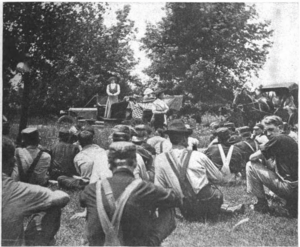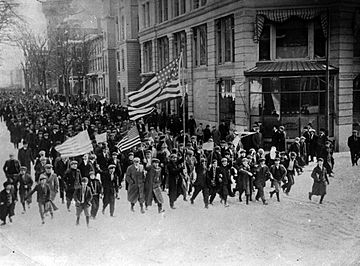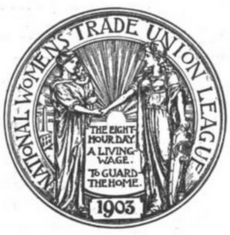Bread and Roses facts for kids
"Bread and Roses" is a well-known political slogan. It is also the name of a famous poem and song. The idea came from a speech by Helen M. Todd, an American activist who fought for women's right to vote. She spoke about "bread for all, and roses too." This line inspired James Oppenheim to write his poem Bread and Roses.
The poem was first printed in The American Magazine in December 1911. It said the phrase was a slogan used by women in the West. The poem has been translated into many languages. At least three different people have set it to music.
The phrase is often linked to the textile strike in Lawrence, Massachusetts. This strike happened between January and March 1912. It is now often called the "Bread and Roses strike." The slogan means people want fair pay (bread) and also good, respectful working conditions (roses). It shows that workers fight for dignity, not just money.
Contents
How the Slogan Started
Women Fighting for the Right to Vote

The phrase "bread and roses" first appeared in The American Magazine in September 1911. Helen Todd wrote an article about it. She described how women from the Chicago Woman's Club started a campaign in June 1910. They drove around Illinois to get women the right to vote.
The first group of women on this trip included a lawyer, a doctor, a minister, a singer, and Helen Todd. Helen Todd was a factory inspector. She talked about working women and the need for better laws. These laws would cover wages, work conditions, and hours.
In Helen Todd's speech, the phrase "bread and roses" was first heard. A young girl told Helen Todd what she liked most about the speeches. She said it was "that about the women votin' so's everybody would have bread and flowers too." Helen Todd then explained what "Bread for all, and Roses too" meant. She said it showed the true spirit of the women's movement.
Woman is the mothering element in the world. Her vote will help bring a time when life's Bread (home, shelter, security) and the Roses of life (music, education, nature, books) will be for every child born in this country. She will have a voice in the government.
Women Workers Speak Up
After this, Helen Todd joined the 1910 Chicago garment workers' strike. This strike was led by the Women's Trade Union League of Chicago. This group worked with the Chicago Women's Club. They organized the strike, picket lines, speeches, and helped workers.
Helen Todd and Margaret Dreier Robins, the League's president, gave many speeches. They also joined thousands of striking garment workers on the picket lines. Later, it was reported that a sign was seen during the strike. It read, "We want bread – and roses, too."
In 1911, Helen Todd went to California. She helped lead the fight for women's right to vote there. The campaign was successful. Women in California gained the right to vote in November 1911. During this campaign, the women carried banners with slogans. One banner said, "Bread for all, and Roses, too!" This was the same phrase Helen Todd used in her speech.
The Famous Poem
James Oppenheim then used the phrase in his poem 'Bread and Roses'. It was published in The American Magazine in December 1911. It said the phrase was "a slogan of the women in the West." The poem was printed again in July 1912 in The Survey. It was also in The Public in October 1912. This time, the slogan was linked to the "Chicago Women Trade Unionists."
The Lawrence Textile Strike
The poem first appeared in a book in 1915. It was in The Cry for Justice by Upton Sinclair. This time, the poem had a new note. It said, "In a parade of strikers of Lawrence, Mass., some young girls carried a banner inscribed, 'We want Bread, and Roses too!'"
The 1912 Lawrence textile strike lasted from January to March 1912. Many immigrant communities joined together. The Industrial Workers of the World led the strike. Women played a big role in it. The Women's Trade Union League of Boston also helped. They set up a place to give out food.
However, the Boston League was not fully involved. This was because they were part of the American Federation of Labor (AFL), which did not support the strike. Some members of the Boston League quit because of this. One person said the AFL seemed "selfish" and "remote from the struggle for bread and liberty." Many stories say women carried signs that said "We want bread, but we want roses, too!" during the strike. But some historians believe this might not be entirely true.
A Powerful Speech by Rose Schneiderman
In May 1912, Merle Bosworth gave a speech in Plymouth, Indiana. She talked about women's right to vote. She also repeated the meaning of "Bread and Roses" that Helen Todd had shared. A month later, in June 1912, Rose Schneiderman spoke in Cleveland. She was from the Women's Trade Union League of New York. She supported women's right to vote in Ohio.
In her speech, partly printed in the journal Life and Labor, she said:
What the woman who labors wants is the right to live, not simply exist. She wants the right to life as the rich woman has it. She wants the sun and music and art. You have nothing that the humblest worker does not have a right to have also. The worker must have bread, but she must have roses, too. Help, you women of privilege, give her the ballot to fight with.
—Rose Schneiderman, 1912.
Rose Schneiderman gave many speeches where she repeated this quote. Because of this, her name became strongly linked to the phrase "bread and roses." A year after Oppenheim's poem and Schneiderman's speech, the phrase had spread across the country. For example, in July 1913, a parade in Maryland had a float. Its theme was "Bread for all, and roses, too." The float had a boat with three children. A boy had a basket of bread, and two girls had a basket of roses.
Where Did the Idea Come From?
No one knows for sure where Helen Todd got the idea for "bread and roses." But there is a similar quote from an ancient Roman doctor and philosopher named Galen. In 1838, Edward William Lane translated a book called One Thousand and One Nights. In his notes, he mentioned that Galen said: "He who has two cakes of bread, let him dispose of one of them for some flowers of narcissus; for bread is the food of the body, and the narcissus is the food of the soul."
This idea, that poor people lacked not only food but also beauty for their souls, was a common theme among reformers. In April 1907, Mary Macarthur from the British Women's Trade Union League visited Chicago. She gave a speech about this idea. Alice Henry of the Chicago League said Macarthur's message was like Galen's quote. Macarthur's version of the quote was:
If thou hast two loaves of bread, sell one and buy flowers, for bread is food for the body, but flowers are food for the mind.
The "Bread and Roses" Poem
Bread and Roses
As we come marching, marching, in the beauty of the day,
A million darkened kitchens, a thousand mill-lofts gray
Are touched with all the radiance that a sudden sun discloses,
For the people hear us singing, "Bread and Roses, Bread and Roses."
As we come marching, marching, we battle, too, for men—
For they are women's children and we mother them again.
Our days shall not be sweated from birth until life closes—
Hearts starve as well as bodies: Give us Bread, but give us Roses.
As we come marching, marching, unnumbered women dead
Go crying through our singing their ancient song of Bread;
Small art and love and beauty their trudging spirits knew—
Yes, it is Bread we fight for—but we fight for Roses, too.
As we come marching, marching, we bring the Greater Days—
The rising of the women means the rising of the race.
No more the drudge and idler—ten that toil where one reposes—
But a sharing of life's glories: Bread and Roses, Bread and Roses.—James Oppenheim, 1911.
The "Bread and Roses" Song
Early Music Versions
The poem 'Bread and Roses' has been set to music many times. The first person to put it to music was Caroline Kohlsaat in 1917. Her song was first performed at the River Forest Women's Club. Kohlsaat was the chorus director there.
Kohlsaat's song eventually became popular on picket lines. By the 1930s, women used the song a lot. They sang it while feeding and supporting strikers at factories. The song also spread to college campuses. At some women's colleges, it became a traditional song.
Sung at Colleges
Since 1932, graduating students at Mount Holyoke College sing the song. They sing it during their Laurel Parade ceremony, a graduation tradition. It is also a main song at Bryn Mawr College. They traditionally sing it at "Step-Sings."
The song's use at Bryn Mawr College came from a special summer program. In 1921, the school started the Bryn Mawr Summer School for Women Workers in Industry. Each year, one hundred workers from factories and sweatshops came to the school. They studied humanities and learned about worker solidarity for eight weeks. This program became a model for other worker education programs.
Reaching More People
The song became even more popular after World War II. It was published in Sing Out! in January 1952. In 1974, Mimi Fariña set the poem to music again. Many artists have recorded her version. These include Judy Collins, Ani DiFranco, Utah Phillips, and Josh Lucker. John Denver also set it to music in 1988. His melody is different from Mimi Fariña's popular version.
In Germany, Renate Fresow also set it to music. She used a translation by the Hannoveraner Weiberquartett. However, it is mostly sung with the German translation by Peter Maiwald. Composer Christian Wolff wrote a piano piece called "Bread and Roses" (1976). It was based on the strike song. In 1989/91, Si Kahn wrote a song. Its chorus starts with the song's title: "They all sang 'Bread and Roses'."
Translations
The poem has been translated into Russian by the poet Kirill Felixovich Medvedev. It is set to the original Kohlsaat music. The Moscow-based punk group Arkadiy Kots (Аркадий Коц) performed it. It appeared on their 2016 album Music for the working class.
Its Lasting Impact
Mimi Fariña started the Bread and Roses Benefit Agency in 1974. This group helps bring free entertainment to people in hospitals, nursing homes, and other institutions.
The logo for the Democratic Socialists of America, formed in 1982, was inspired by the slogan. "Bread & Roses" is also the name of a group within this organization. They have 4 members on the DSA's National Political Committee.
Miriam Schneir included the poem in her book, Feminism: The Essential Historical Writings. She called it one of the most important works of feminism.
See also
 In Spanish: Queremos pan y también rosas para niños
In Spanish: Queremos pan y también rosas para niños





